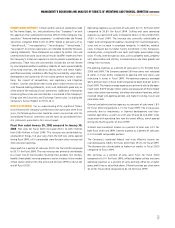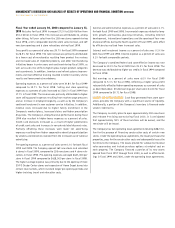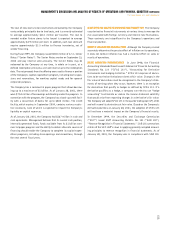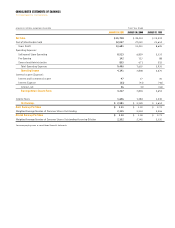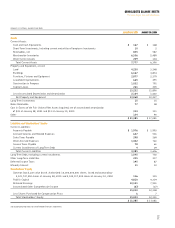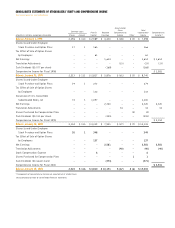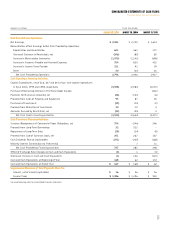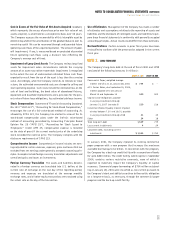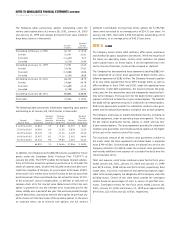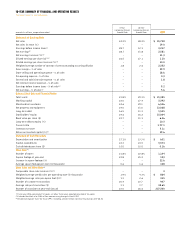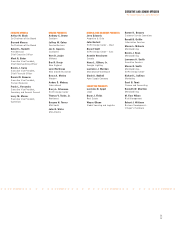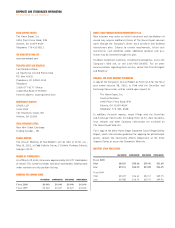Home Depot 2000 Annual Report Download - page 28
Download and view the complete annual report
Please find page 28 of the 2000 Home Depot annual report below. You can navigate through the pages in the report by either clicking on the pages listed below, or by using the keyword search tool below to find specific information within the annual report.
Notes to Consolidated Financial Statements (continued)
The Home Depot, Inc. and Subsidiaries
During fiscal 1999, the Company issued $500 million of 61⁄2% Senior
Notes (“Senior Notes”). The Senior Notes may be redeemed by the
Company at any time, in whole or in part, at a redemption price plus
accrued interest up to the redemption date. The redemption price is
equal to the greater of (1) 100% of the principal amount of the Senior
Notes to be redeemed or (2) the sum of the present values of the
remaining scheduled payments of principal and interest to maturity.
The Senior Notes are not subject to sinking fund requirements.
During 1999, the Company redeemed its 31⁄4% Convertible
Subordinated Notes (“31⁄4% Notes”). A total principal amount of
$1.1 billion was converted into 72 million shares of the Company’s
common stock.
Interest expense in the accompanying Consolidated Statements of
Earnings is net of interest capitalized of $73 million in fiscal 2000,
$45 million in fiscal 1999 and $31 million in fiscal 1998.
Maturities of long-term debt are $4 million for fiscal 2001, $42 mil-
lion for fiscal 2002, $5 million for fiscal 2003, $507 million for
fiscal 2004 and $761 million for fiscal 2005.
As of January 28, 2001, the market value of the publicly traded
Senior Notes was approximately $515 million. The estimated fair
value of commercial paper borrowings approximates their carry-
ing value. The estimated fair value of all other long-term borrowings,
excluding capital lease obligations, was approximately $67 million
compared to the carrying value of $65 million. These fair values were
estimated using a discounted cash flow analysis based on the
Company’s incremental borrowing rate for similar liabilities.
Note 3. Income Taxes
The provision for income taxes consisted of the following (in millions):
Fiscal Year Ended
January 28, 2001 January 30, 2000 January 31, 1999
Current:
U.S.
$ 1,267
$ 1,209 $ 823
State
216
228 150
Foreign
45
45 20
1,528
1,482 993
Deferred:
U.S.
98
946
State
9
(4) (1)
Foreign
1
(3) 2
108
247
Total
$ 1,636
$ 1,484 $ 1,040
The Company’s combined federal, state and foreign effective tax rates
for fiscal years 2000, 1999 and 1998, net of offsets generated by
federal, state and foreign tax incentive credits, were approximately
38.8%, 39.0% and 39.2%, respectively. A reconciliation of income
tax expense at the federal statutory rate of 35% to actual tax expense
for the applicable fiscal years follows (in millions):
Fiscal Year Ended
January 28, 2001 January 30, 2000 January 31, 1999
Income taxes at U.S.
statutory rate
$ 1,476
$ 1,331 $ 929
State income taxes, net of
federal income tax benefit
146
145 96
Foreign rate differences
5
2–
Other, net
9
615
Total
$ 1,636
$ 1,484 $ 1,040
The tax effects of temporary differences that give rise to significant
portions of the deferred tax assets and deferred tax liabilities as of
January 28, 2001 and January 30, 2000 were as follows (in millions):
January 28, 2001 January 30, 2000
Deferred Tax Assets:
Accrued self-insurance liabilities
$ 151
$ 154
Other accrued liabilities
118
142
Total gross deferred tax assets
269
296
Deferred Tax Liabilities:
Accelerated depreciation
(389)
(321)
Other
(75)
(62)
Total gross deferred tax liabilities
(464)
(383)
Net deferred tax liability
$ (195)
$ (87)
No valuation allowance was recorded against the deferred tax assets
at January 28, 2001 and January 30, 2000. Company management
believes the existing net deductible temporary differences comprising
the total gross deferred tax assets will reverse during periods in which
the Company generates net taxable income.



